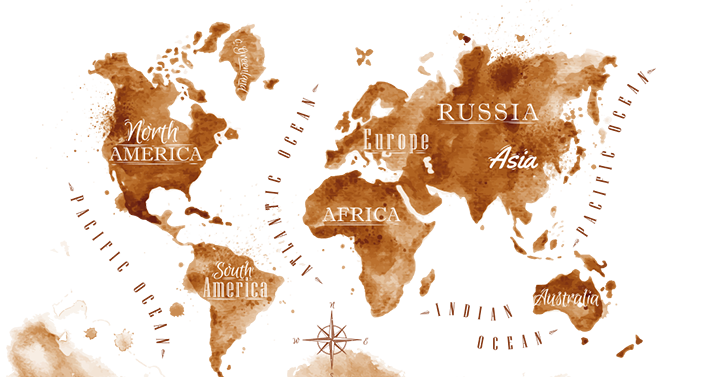WORLD MAP OF COFFEE
Not anywhere in the world can grow coffee. After many generations, coffee growers have learned that coffee can only be grown in places with cool weather throughout the year, abundant rainfall and sunshine. Such conditional lands lie around or below the equatorial belt that includes Central America, Africa, Central Asia and Southeast Asia. Therefore forming a belt of coffee called ‘The Bean Belt’. In this belt, more than 75 countries have the right conditions to cultivate coffee with soil, which is characteristic of the taste. Countries with high humidity will cause the coffee to be quickly hygroscopic, early to ripen and produce very tasteless coffee compared to coffee grown in highland with low humidity. The following is a list of some famous coffee growing regions.
North America and the Caribbean
Hawaii – The only state to grow coffee in America. This is the most famous island in the world. When it comes to Hawaii one can not help but mention Kona coffee, planted on the lowlands of Hualalai volcanoes and Mauna Loa. The soil around the volcano has a lot of minerals, abundant rainfall and cloud cover always cover the hot tropical heat has helped Kona coffee has a very strong flavor and ecstatic aroma.
Mexico – Coffee is mainly concentrated in the south of the country such as Veracruz, Oaxaca and Chiapas. Although only planted in relatively modest plantations, Mexico’s coffee farms make an impressive number, 100,000. That’s because of that diversity Mexico has in the coffee market. Complex with many different types of coffee. Basically, they taste quite bold, but the smell is bad.
Jamaica – Great climate conditions help Jamaica produce one of the world’s finest coffee Blue Mountain. They have a sour taste, balance with the aroma of herbs and sweet bold. Price is not cheap at all, more than 80 USD / 1kg.
Central America
Costa Rica – The reputation of Costa Rica’s coffee is not due to climatic or soil conditions but to the feat in the process of caring for coffee. After harvesting, the coffee is processed in a very rigorous manner. Costa Rican coffee has a sour, sweet, almost balanced balance, along with the delicate scent of spring grass flowers.
Guatemala – Hundreds of years before the volcano erupted, the lava released to create a mineral rich soil, making coffee in this area has a rather subtle taste structure. Strictly Hard Bean is Guatemala’s own hard-boiled grain that can be found in the coffee market, as it is grown at over 1500m.
Panama – When I was talking about Central America, I just wanted to drink a glass of Panama Geisha. This is the perfect coffee to make coffee as Plunger or Filter bag. The taste of this fresh, smooth, perfect coffee is the perfect combination between the sour taste of strawberry, the sweetness of honey, the aroma of peach. Only a handful of farms in Panama are eligible to produce such coffee. The price that we pay for them is very chatty, more than 260 USD / 1kg.
South America
Brazil – The largest coffee exporter, accounting for over 30% of the world market for the last 150 years. 80% of Brazilian coffee is Arabica, the other is Robusta, which is Semi-washed. The main reason Brazilian coffee is popular is the price but popular, but the quality is superior. They have a sweet taste, high sweetness and less sour.
Colombia – Colombia is a very famous coffee country. Colombian coffee uses an incredibly high quality rating. Like Mexico and Colombia, fragmentation of the farming system in small farms across the country, where weather and soil conditions are almost perfect. However, the terrain is so rough that it is difficult to move. Colombian coffee, especially Supremo and Excelso, neutral, slim, balanced acidity, aromatic.
Africa and Middle East
Ethiopia – Coffee was first cultivated in southern Ethiopia. Harrar and Yergahcheffe most famous in this country have a strong taste, full round, high sweetness.
Kenya – Kenyan coffee is popular in the United States and Europe, grown at the foot of Mount Kenya. In addition to the coarse processing and special monitoring processes, Kenya has the unique green coffee classification method. After polishing, coffee beans are very light color, the essence of the extract is quite similar to red wine. Attractive, round and high acidity.
Tanzania – If Vietnam has the famous Culi coffee, Tanzania is also like Peaberry. Unlike other types of coffee, Peaberry has only one grain in one fruit. Planted at the foot of the majestic Mount Kilimanjaro, Peaberry has its own unique flavor.
Yemeni – Due to the dry climate, coffee grown in Yemeni produces seeds that are much smaller than normal. After harvesting, the coffee is treated dry-process to have a deep taste. Yemeni combines indigenous coffee with Indonesia’s Java variety to create the famous Mocha Java coffee.
Asia and Indonesia
Java, Indonesia – In addition to Java, the most famous island in the Indonesian archipelago system, where coffee is bold, sweet, long tan mingled with aromatic herbs. Indonesia also owns one of the world’s most expensive coffees, the Luwak coffee. Coffee beans pass through the secretion system of the luwak before being washed and treated, helping the coffee to ferment and taste very different. However, enjoying this strange coffee has a terrible price, more than 350 USD/kg.
Sumatra – Going further to the west coast of Indonesia is the Sumatra island. The north of the island has a land called Mandheling, which is also the name of the coffee here. Sour, dry, neutral taste, blended in the characteristic herbs, very suitable for mixing coffee filter.
India – Coffee grown in India is quite similar to Indonesia’s Java coffee. The beans from the Kerala area, Karnatka, Tamilnadu are very tasty. The characteristic of the coffee is that they are harvested while still green, then exposed in monsoon weather conditions from 3 to 4 months to reduce acidity and enhance sweetness.
Vietnam – Despite being grown in many places along the length of the country, but now only the Central Highlands is for quality coffee. As the largest producer of Robusta in the world, Vietnam still needs a lot of effort in improving its cultivation technology and applying modern processing to confirm its name in the world market.

If you are traveling, instead of having a cup of coffee in the hotel, go to a local coffee shop, enjoy a cup of coffee, or simply buy some coffee. There is no more lively and wonderful travel experience than sipping a cup of aromatic coffee in the land itself.
Contact:
[contact-form-7 404 "Not Found"]
Hoặc liên hệ
CÔNG TY TNHH DƯƠNG CAFE
ĐC: 107C Minh Khai, Phường Minh Khai, Quận Hai Bà Trưng, TP.Hà Nội
Hotline: 0912 104 901
Email: duongtamthanh@gmail.com – info@duongcafe.com




